Apple Inc. was founded in 1976 in California, USA by Steve Jobs, Steve Wozniak and Ronald Wayne. Apple Inc. became one of the most valuable companies in the world and is currently one of the Big Four technology companies alongside Facebook, Google and Amazon. In early 2019, it reclaimed the title of the most valuable public company in the world, ahead of Microsoft and Amazon.
Here are 20 interesting facts about Apple:
Interesting Facts About Apple
1. Personal Assets to Fund Apple

Steve Jobs sold his Volkswagen Microbus for $750 and Wozniak sold his HP65 scientific calculator for $500 to raise funds to start Apple.
In the early days of Apple Inc., co-founders Steve Jobs and Steve Wozniak made significant personal sacrifices to raise the initial capital needed to launch their groundbreaking company. Jobs sold his beloved Volkswagen Microbus for $750, while Wozniak parted with his HP65 scientific calculator for $500.
These sales, though seemingly modest, played a crucial role in financing the development of their first product, the Apple I computer. At that time, both Jobs and Wozniak were driven by their passion for technology and innovation, willing to part with personal belongings to pursue their entrepreneurial vision.
The Apple I, which they assembled in Jobs’s garage, marked the beginning of a technological revolution. With their combined $1,250, they were able to cover the costs of components needed to build the computers. This determination and resourcefulness laid the foundation for what would eventually become one of the most influential companies in the world. The sacrifices made by Jobs and Wozniak reflect their commitment to their dream and foreshadowed the extraordinary impact Apple would have on the tech industry and consumer electronics.
2. Apple Had Three Co-Founders
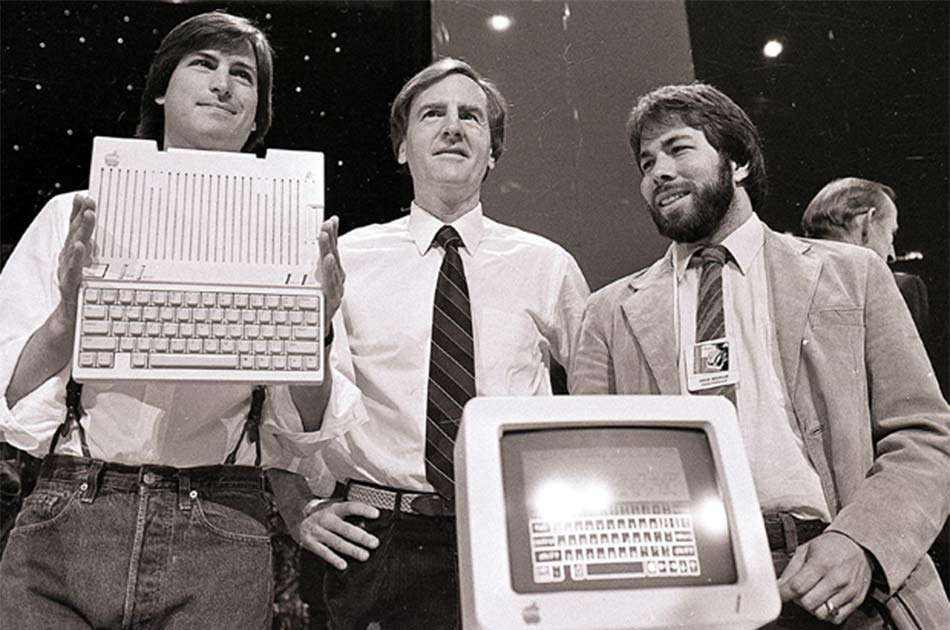
Apple originally had three co-founders. The third co-founder, Ronald Wayne, had joined Steve Jobs and Steve Wozniak. Ronald Wayne’s journey with Apple didn’t last long and he left the company only 12 days after it was founded. Wayne sold his 10% share for just $800 and got an additional payout of $1,500. If he had stayed with the company, the worth of his shares would be around $60 billion!
Apple Inc. was originally co-founded by three individuals: Steve Jobs, Steve Wozniak, and Ronald Wayne. While Jobs and Wozniak are widely recognized for their roles in building the company, Wayne’s involvement was short-lived. He joined Apple in its early days but decided to leave the company just 12 days after its founding in 1976.
Wayne, who was concerned about the financial risks associated with the new venture, sold his 10% stake in Apple for a mere $800. In addition to this sale, he received an extra payout of $1,500 to relinquish his rights to any further claims on the company.
In hindsight, Wayne’s decision to exit Apple proved to be monumental. If he had retained his shares, they would have been worth an astonishing $60 billion today, reflecting the tremendous growth and success that Apple has achieved over the decades. This story serves as a poignant reminder of the unpredictable nature of entrepreneurial endeavors and the potential for immense wealth in the tech industry. Wayne’s choice exemplifies how early decisions can shape the course of one’s life and career, particularly in a company that would become a global powerhouse.
3. Because Steve Jobs Really Liked Apples

In Walter Isaacson’s, Steve Jobs reveals that he’d come up with the name while “on one of my fruitarian diets.” Having just visited an apple farm Steve thought the name sounded “fun, spirited and not intimidating.”
In Walter Isaacson’s biography, Steve Jobs, the iconic co-founder of Apple Inc. shares the intriguing origin of the company’s name. Jobs revealed that the idea for the name “Apple” came to him during one of his fruitarian diets. After visiting an apple farm, he found inspiration in the simplicity and charm of the fruit. He thought the name sounded “fun, spirited, and not intimidating,” which perfectly aligned with his vision for the company.
Jobs aimed to create a brand that was approachable and accessible, contrasting sharply with the often complex and technical nature of computers at the time. He believed that the name Apple would resonate with consumers and convey a sense of creativity and innovation. This playful, friendly branding helped set Apple apart from its competitors, making it memorable and inviting to a broader audience.
Jobs’s connection to the name reflects his larger philosophy of integrating design and user experience into technology, emphasizing that products should be delightful and easy to use. Ultimately, the choice of the name “Apple” marked the beginning of a transformative journey in the tech industry, leading to the establishment of one of the most recognizable and influential brands in the world.
4. The Bill Gates connect
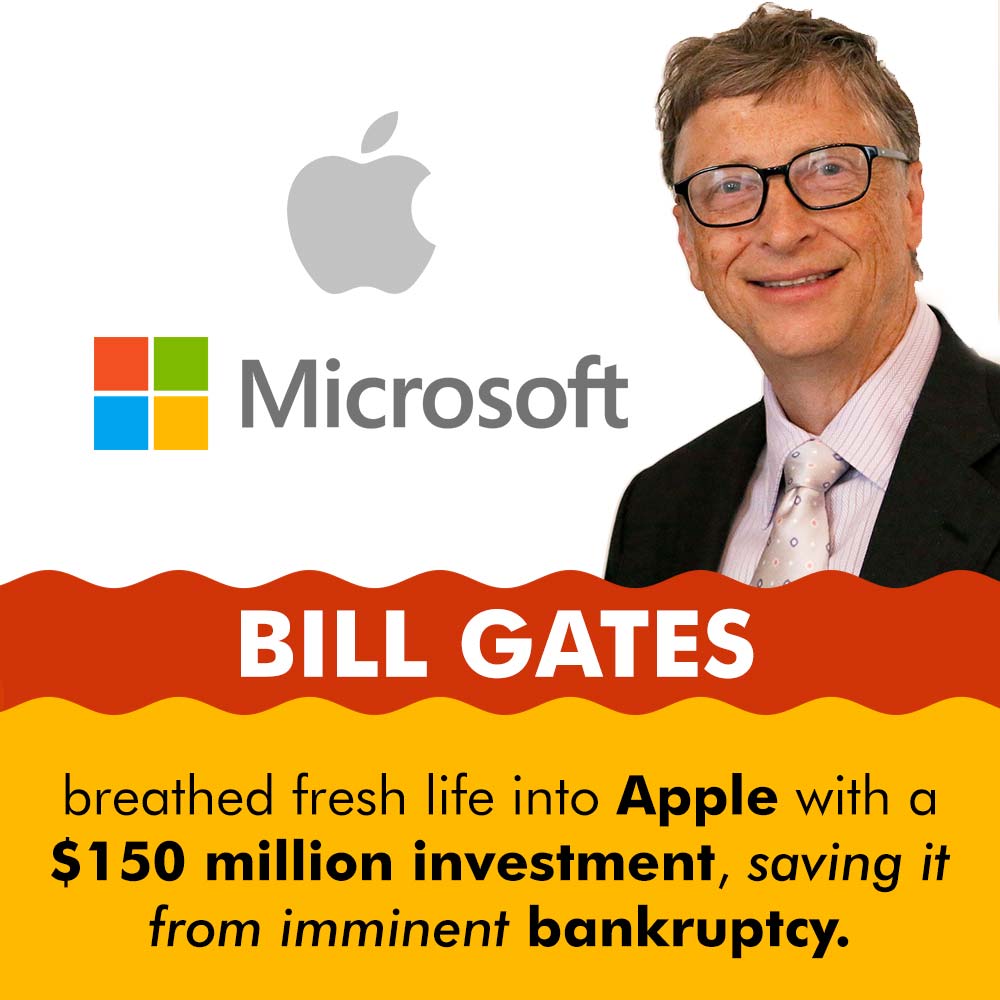
In 1997, Bill Gates breathed fresh life into Apple with a $150 million investment, saving it from imminent bankruptcy.
In 1997, Bill Gates breathed fresh life into Apple with a $150 million investment, saving it from imminent bankruptcy. Share on XIn 1997, a pivotal moment in tech history unfolded when Microsoft co-founder Bill Gates made a significant $150 million investment in Apple Inc. This move not only saved Apple from the brink of bankruptcy but also reshaped the dynamics of the technology industry.
By the late 1990s, Apple was struggling. The company was facing severe financial difficulties, with declining sales and a series of unsuccessful product launches. Its market share was shrinking, and it had been losing money for several consecutive quarters. The perception of Apple was that it was on the verge of extinction, with many industry observers predicting its imminent collapse.
At the same time, Microsoft was experiencing tremendous growth. It dominated the personal computer market with its Windows operating system, while Apple’s Macintosh platform struggled to compete. The rivalry between the two companies was intense, characterized by a series of legal battles and competitive strategies.
In this challenging context, Gates’s investment in Apple was both a financial lifeline and a strategic maneuver. In August 1997, Microsoft agreed to invest $150 million in Apple in the form of non-voting shares. This investment was not merely about providing cash; it was also accompanied by a commitment to continue developing Microsoft Office for Mac and to support the Mac platform for at least five years.
The deal was announced at a press conference where Gates famously appeared on screen via satellite. This was significant, as it marked a rare moment of collaboration between two of the most prominent rivals in the tech industry. Gates stated, “Apple is a company that has always had an important place in the industry, and we are committed to helping it succeed.”
The immediate impact of Gates’s investment was substantial. The influx of $150 million provided Apple with much-needed liquidity, allowing it to stabilize its finances. This support was crucial as Apple sought to revamp its product line and innovate for the future.
Additionally, the deal restored confidence among investors and consumers, signaling that Apple was not going to disappear. It allowed the company to focus on developing groundbreaking products that would eventually change the landscape of personal computing.
Following the investment, Apple underwent a significant transformation. In 1997, Steve Jobs, who had returned to Apple after being ousted in the mid-1980s, implemented a series of changes that would revitalize the company. Under Jobs’s leadership, Apple launched innovative products like the iMac in 1998, which helped revive its brand and sales.
The collaboration with Microsoft also led to the development of crucial software, enhancing the Mac’s usability and appealing to a broader audience. The investment marked the beginning of a new era for Apple, one that would eventually lead to its resurgence as a tech giant.
The $150 million investment had long-lasting implications beyond just saving Apple. It altered the competitive landscape of the tech industry. The collaboration between Apple and Microsoft laid the groundwork for a more interconnected ecosystem where different platforms could coexist, and companies could cooperate even amidst rivalry.
Moreover, this investment is often cited as a turning point in Apple’s history, leading to its transformation into one of the most valuable companies in the world. The strategies and innovations that emerged in the years following Gates’s investment played a crucial role in shaping modern technology and consumer electronics.
5. Steve Jobs – In the line of fire
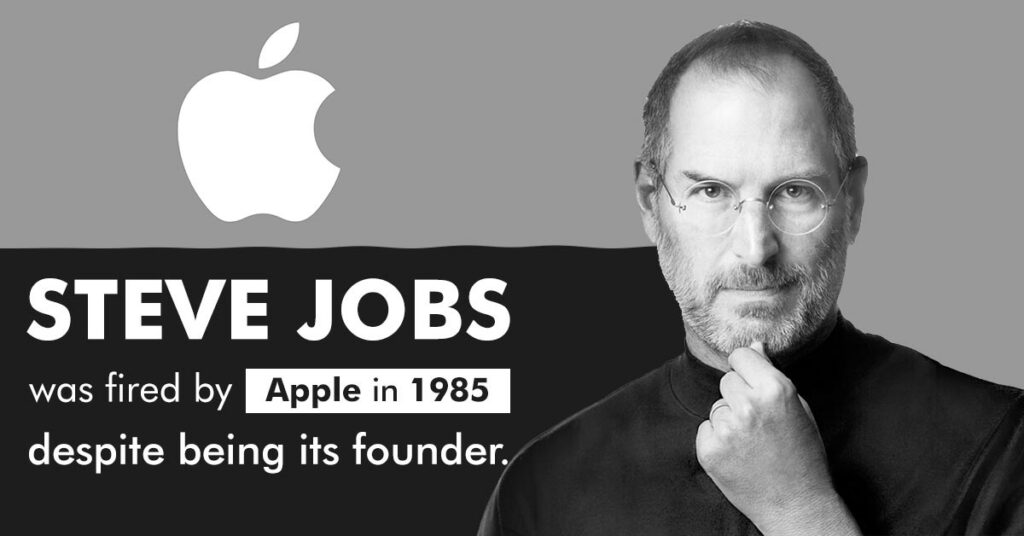
Steve Jobs was fired by Apple in 1985, despite being its founder.
After a few years of starting Apple, Steve Jobs realised a need for a person who could create business strategies and spread Apple internationally. So he hired John Sculley, the Ex CEO of PepsiCo, to run the company alongwith him.
After the failure of Mac Lisa, mainly because of its hefty price tag, Steve Jobs and John Sculley had different ideas regarding the future of Apple. Steve Jobs believed in creating “revolutionary and world-changing” products, while John Sculley wanted to make profits.
Arguments heated up between the two. The Board of directors held a vote and came to the conclusion to fire Steve Jobs.
Undoubtedly, it’s amongst the most interesting facts about Apple.
Steve Jobs was fired by Apple in 1985, despite being its founder. Share on X6. The ‘i’ in the Name
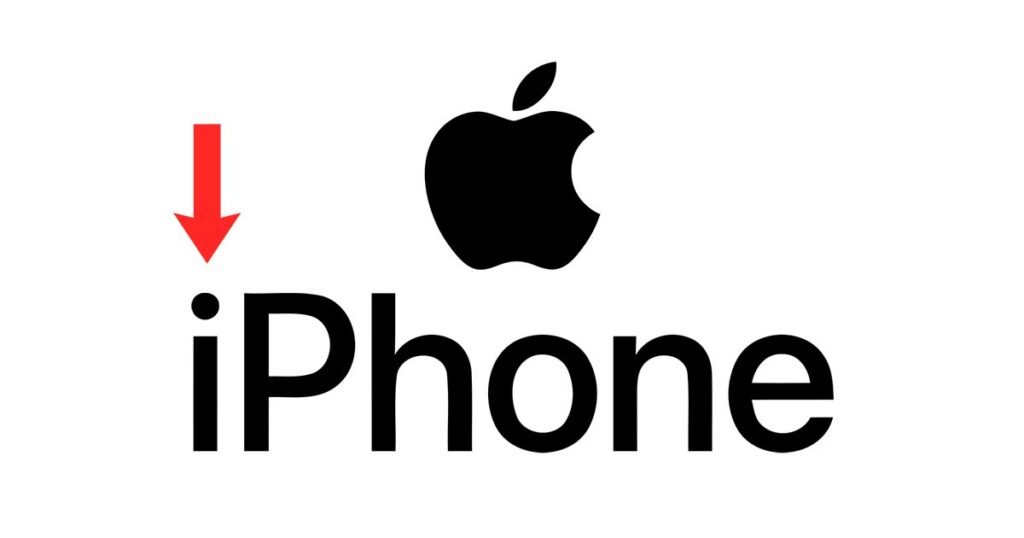
The ‘i’ in the Apple products stand for internet, individuality and innovation.
Today, Apple operates more than 500 stores in around 20 countries and is a trillion-dollar company. A company known for its unique innovations in technology, there is much more coming up from the side of Apple to mesmerize its customers in the near future.
7. The Apple I Cost $666.66
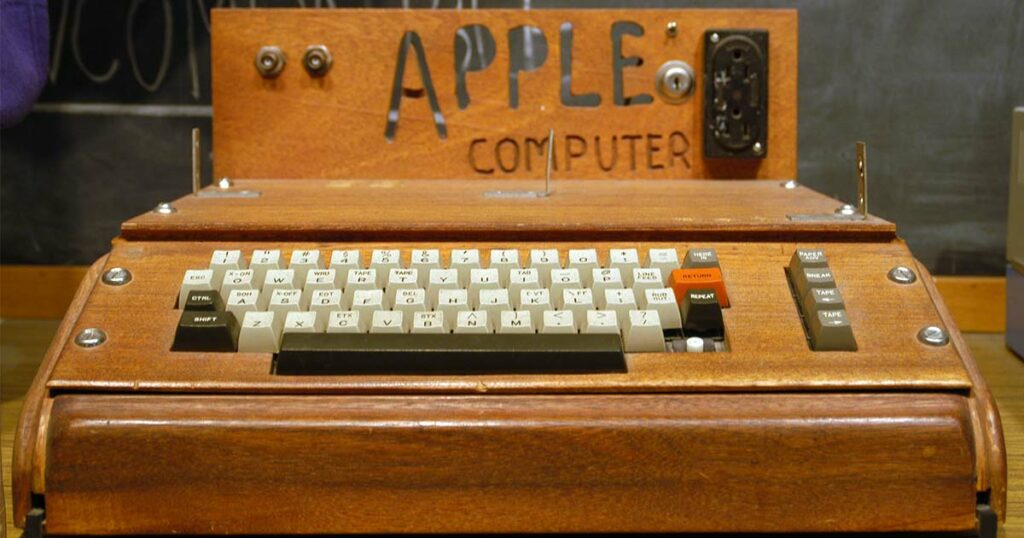
The high prices of Apple devices have always been among critics’ biggest complaints. But if we look back at the early days of Apple, their devices always boasted a higher price tag. If you account for inflation, back in the day, the Apple I would have been more expensive than the current MacBook Air or even a MacBook Pro.
There are rumours on the internet that the first Apple computer was built for $666.66 in a devilish twist. Instead for more pragmatic reasons, as Steve Wozniak once clarified at a news conference, “I was into repeating digits”. He worked a deal to sell computers wholesale price to the store for $500 and adding a third to get the retail price made it around $667, which Steve Wozniak changed to all one repeating digit — $666.66.
8. No Samba beats
Apple could not sell its products in Brazil for a long time, as the name was copyrighted by a company called IGM electronics there.
9. Apple Devices Detect Smoke
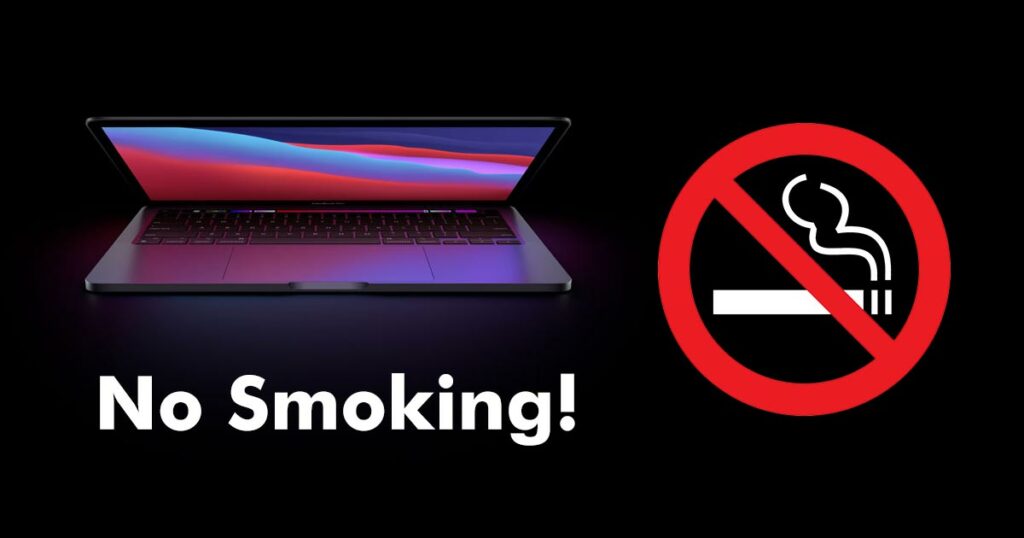
Apple has a ‘no smoking’ ban regarding their computers. Apple devices detect smoke and smoking around the Apple computers leads to the void of warranty.
Apple has implemented a stringent ‘no smoking’ policy concerning the use of its computers and devices. This policy stems from the potential damage that smoke can cause to electronic equipment. Apple devices are equipped with sensors that can detect smoke in their vicinity, allowing them to identify when smoking is occurring near the equipment.
As part of their warranty terms, Apple states that exposure to smoke can lead to damage that is not covered by the warranty. This means that if a device is found to have been exposed to smoke, any repairs or replacements resulting from that exposure may be deemed ineligible for warranty service. The rationale behind this policy is to protect the integrity and longevity of their products, as smoke can leave residues that interfere with the device’s performance and functionality.
By enforcing this policy, Apple emphasizes its commitment to maintaining high standards of quality and reliability for its products. This approach not only safeguards their technology but also encourages users to create a healthier environment for their devices, ultimately enhancing the overall user experience.
10. iPhone Gratis
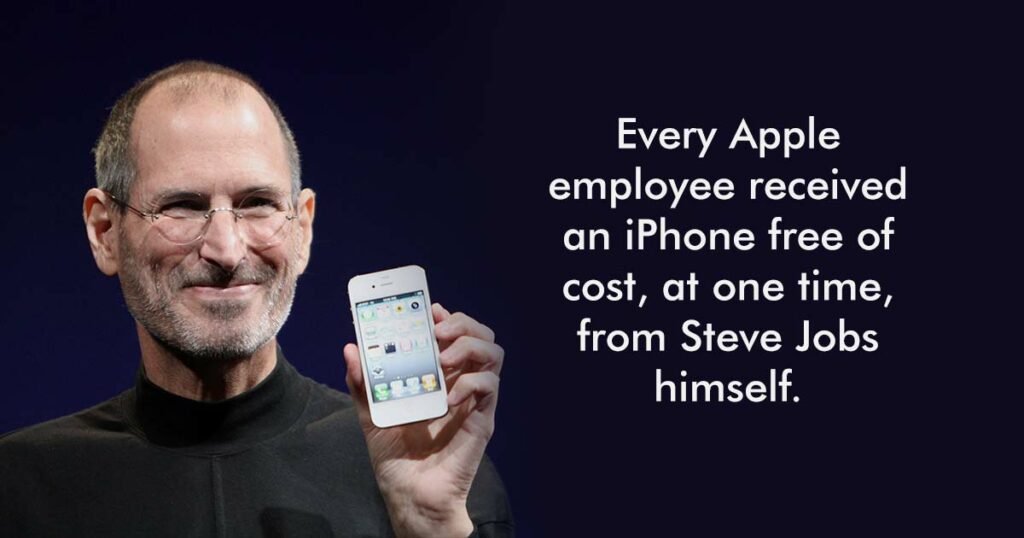
Every Apple employee received an iPhone free of cost, at one time, from Steve Jobs himself.
In a notable gesture that exemplified Steve Jobs’s leadership and the company’s culture, every Apple employee received a free iPhone at the time of its launch in 2007. This initiative was part of Jobs’s vision to foster a sense of belonging and excitement among Apple employees as they introduced a groundbreaking product that would redefine the smartphone industry.
By gifting the iPhone to all employees, Jobs not only encouraged them to familiarize themselves with the device but also instilled a sense of pride and ownership in the product they were helping to create. This practice aligned with Apple’s emphasis on innovation and quality, as employees who used the iPhone could directly experience its features and functionality, enabling them to advocate for the product confidently.
The move also reinforced the idea that Apple was not just a company producing products; it was a community of passionate individuals working toward a common goal. The gesture symbolized Jobs’s belief in the importance of empowering employees and fostering a strong corporate culture, ultimately contributing to Apple’s success as one of the most influential technology companies in the world.
11. Apple Lisa
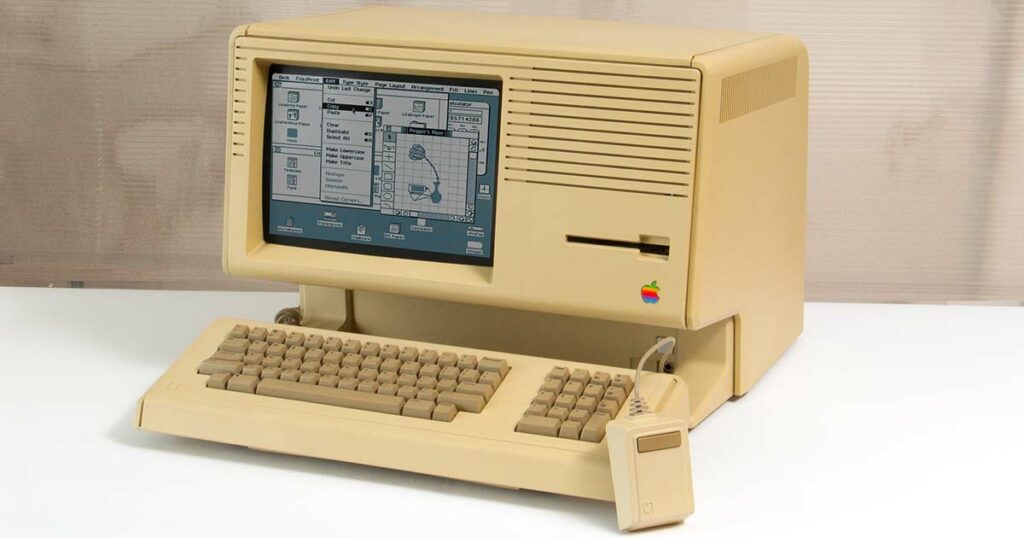
Apple Inc. is not only a series of success stories. In 1983, it launched Lisa, a line of computers. Lisa did a lot of amazing things. It was the first computer with Graphical User Interface (GUI). It was super powerful but too darn expensive. The introductory price was US$9,995 (equivalent to $25,970 in 2020). Lisa tanked miserably.
Apple Inc.’s journey is not solely defined by its triumphs; it also includes notable missteps, one of the most prominent being the launch of the Apple Lisa in 1983. The Lisa was ambitious and groundbreaking, as it was the first personal computer to feature a Graphical User Interface (GUI). This innovative approach aimed to make computers more user-friendly, allowing users to interact with the device through visual icons and menus instead of command-line text.
Despite its technological advancements, the Lisa faced significant challenges. The introductory price of $9,995—equivalent to approximately $25,970 in 2020—proved to be a substantial barrier for potential customers. At such a high price point, the Lisa was inaccessible to the average consumer, which limited its market appeal. Additionally, the computer’s performance, while impressive for its time, struggled to justify its steep cost, leading to consumer reluctance.
Ultimately, the Apple Lisa tanked miserably in the market. It was discontinued just a few years after its release, and the lessons learned from the Lisa experience informed Apple’s future product strategies. The failure of the Lisa highlights the importance of not only innovation but also market viability and pricing strategy in the competitive technology landscape.
12. The Airway
Apple does not ship any product in any way other than air.
Apple has adopted a shipping strategy that primarily relies on air transportation for delivering its products. This approach ensures that their devices reach customers quickly and efficiently, aligning with the company’s commitment to providing a seamless and timely experience for users.
By using air freight, Apple can expedite the shipping process, reducing delivery times significantly compared to ground shipping methods. This is particularly important for the launch of new products, where high demand often leads to a rush for timely deliveries. Air shipping also enables Apple to maintain better control over the logistics and handling of its products, ensuring that they arrive in excellent condition.
While air shipping is the primary mode of transport for Apple products, it’s worth noting that the company may still utilize ground transportation for certain logistics operations, such as within regions or for less time-sensitive deliveries. However, for international shipping and high-demand periods, air transportation remains the backbone of Apple’s distribution strategy, allowing the company to meet customer expectations for rapid delivery and product availability.
13. Codename Ferrari
Apple products usually have code names. The iPhone X is code-named the ‘Ferrari’.
Apple is known for its practice of using code names during the development of its products, often inspired by cars, animals, or other creative themes. The iPhone X, for instance, was code-named “Ferrari.” This choice reflects the brand’s emphasis on speed, performance, and luxury—attributes commonly associated with the iconic Ferrari sports car.
The use of such code names serves multiple purposes within Apple. First, it helps maintain confidentiality around new products during development, allowing teams to discuss projects without revealing their details to the outside world. Second, code names can create a sense of excitement and aspiration among the development teams, linking their work to high-performance concepts.
The iPhone X was a significant milestone for Apple, marking the 10th anniversary of the iPhone line. It introduced groundbreaking features such as an edge-to-edge OLED display, Face ID technology, and advanced camera capabilities. The “Ferrari” code name aptly encapsulated the device’s cutting-edge technology and premium positioning within Apple’s product lineup, emphasizing the brand’s commitment to innovation and excellence.
14. A Case of Revenue More than GDP
Apple has a yearly revenue greater than the GDP of Iraq and Ecuador. Also, Apple at $2 trillion market cap tops GDP of Brazil, Canada, Italy, Russia and many other countries.
Apple Inc. has consistently demonstrated remarkable financial performance, achieving yearly revenues that surpass the Gross Domestic Product (GDP) of several countries, including Iraq and Ecuador. This impressive feat highlights Apple’s position as one of the most successful and profitable companies in the world.
In recent years, Apple’s revenue has reached astronomical figures, driven by the popularity of its flagship products such as the iPhone, iPad, and Mac, as well as its expanding services sector, which includes the App Store, Apple Music, and iCloud. This robust financial performance underscores the brand’s strong market presence and consumer loyalty.
Furthermore, with a market capitalization that has soared to around $2 trillion, Apple surpasses the GDP of major economies, including Brazil, Canada, Italy, and Russia. This extraordinary valuation reflects investor confidence in Apple’s continued innovation and growth potential. It positions Apple not just as a tech giant, but as an economic powerhouse in its own right, comparable to entire nations.
Such statistics illustrate Apple’s significant influence in the global economy and its status as a leader in the technology sector, showcasing how a single company can achieve financial results that rival those of sovereign nations.
15. The Alan Turing saga
At one time, there was a rumour that Apple was named after the brilliant English mathematician Alan Turing, who committed suicide by cyanide poisoning, and was found with a half-eaten apple by his side.
There has been a persistent rumor that the name “Apple” was inspired by the renowned English mathematician and computer scientist Alan Turing, who is often regarded as a pioneer of modern computing. Turing’s tragic story adds a layer of poignancy to this speculation; he died by suicide in 1954, and his body was discovered with a half-eaten apple nearby, reportedly laced with cyanide.
While this narrative is compelling, the actual origin of Apple’s name is different. Steve Jobs, one of the co-founders of Apple, has stated that the name was chosen after he visited an apple orchard while on a fruitarian diet. He felt the name sounded “fun, spirited, and not intimidating,” which resonated with his vision for the company.
Despite the romanticized link to Turing, it is important to clarify that Jobs himself has denied that the name was a direct homage to the mathematician. Turing’s contributions to computing and his tragic fate are widely acknowledged, and while the story of the half-eaten apple remains a powerful symbol, it is not the true inspiration behind Apple’s name. Instead, the name reflects a blend of simplicity and creativity, aligning with Apple’s innovative spirit and user-friendly philosophy.
16. The Chinese affair
Despite trade wars between the USA and China, China remains the second biggest market for Apple, with annual revenue of around $20 billion.
Despite the ongoing trade tensions between the United States and China, China continues to be a crucial market for Apple Inc., contributing significantly to the company’s overall revenue. In recent years, Apple has generated approximately $20 billion annually from its operations in China, making it the second-largest market for the company after the United States.
Apple’s strong presence in China can be attributed to several factors, including the country’s vast consumer base and the growing demand for premium technology products. The popularity of iPhones, iPads, and Macs among Chinese consumers highlights Apple’s ability to position itself as a premium brand, appealing to customers seeking high-quality devices with advanced features.
Furthermore, Apple has invested heavily in its supply chain and retail operations in China, establishing a network of physical stores and online platforms to enhance its accessibility to consumers. This commitment to the Chinese market has allowed Apple to navigate the complexities of trade relations while maintaining a robust customer base.
Despite the challenges posed by tariffs and other trade restrictions, Apple’s success in China underscores the company’s resilience and adaptability in a rapidly changing global landscape. The strong revenue generated in this market reflects Apple’s strategic focus on international growth and its ability to connect with consumers worldwide.
17. Surpassing the US treasury
At one point in time, the operating cash balance of Apple Inc. was nearly twice that of the US treasury.
At one point in its history, Apple Inc. achieved an extraordinary financial milestone, boasting an operating cash balance that was nearly twice that of the U.S. Treasury. This remarkable feat underscores Apple’s immense profitability and its ability to generate significant cash reserves through its operations.
Apple’s robust cash position can be attributed to its highly successful product lineup, which includes the iPhone, iPad, Mac, and various services like Apple Music and iCloud. The company’s business model, characterized by high margins and strong demand, allowed it to accumulate substantial cash reserves over the years. This financial strength provided Apple with the flexibility to invest in research and development, acquire other companies, and return value to shareholders through dividends and stock buybacks.
The comparison of Apple’s cash reserves to the U.S. Treasury is particularly striking, as it highlights the company’s status as one of the most financially powerful corporations in the world. This financial prowess not only reinforces Apple’s position in the technology sector but also illustrates the growing influence of major corporations in the global economy, rivaling even national treasuries in terms of cash holdings. Such financial strength allows Apple to weather economic uncertainties and continue its innovation-driven growth trajectory.
18. A stroke of luck
The creator of iPod, Tony Fadell, had initially offered the device to Philips, who turned it down. It then went to Apple, who revolutionized the music industry with it.
Tony Fadell, often referred to as the “father of the iPod,” played a pivotal role in the creation of this groundbreaking device that ultimately transformed the music industry. Before the iPod became a global sensation under Apple’s brand, Fadell had initially pitched the idea to Philips, hoping to collaborate on a digital music player. However, Philips decided to turn down the proposal, seeing limited potential in the concept at that time.
Undeterred by this setback, Fadell approached Apple, which was seeking new ways to innovate in the digital music space. In 2001, Apple, under the leadership of Steve Jobs, took a chance on Fadell’s vision and hired him to lead the development of the iPod. The result was a revolutionary device that combined a sleek design with an intuitive user interface, allowing users to carry their entire music library in their pockets.
The launch of the iPod marked a significant turning point in the music industry, as it changed the way people listened to and purchased music. It paved the way for the iTunes Store, which offered a legal platform for downloading music, further reshaping the music distribution model. The iPod’s success not only solidified Apple’s position in the tech industry but also laid the groundwork for future innovations, including the iPhone and iPad, ultimately transforming the way we consume digital media.
19. Shopping day?
Apple has so much excess capital that it could simply buy out Facebook, Netflix or Twitter.
Apple Inc. has amassed an extraordinary amount of excess capital over the years, leading to its status as one of the most valuable companies in the world. With its substantial cash reserves, Apple has the financial flexibility to pursue various strategic initiatives, including acquisitions.
In fact, at various points, analysts have noted that Apple’s cash on hand is so significant that it could theoretically buy out major companies such as Facebook (now Meta Platforms), Netflix, or Twitter (now X). For example, Apple’s cash reserves have been reported to exceed several hundred billion dollars, a sum that far surpasses the market capitalization of these tech giants.
This capability allows Apple to consider significant acquisitions to expand its portfolio, enter new markets, or enhance its existing services. Such acquisitions could help Apple strengthen its ecosystem, integrate new technologies, or gain access to valuable user data and expertise. However, despite its financial prowess, Apple has historically been selective about its acquisitions, often focusing on smaller companies that can enhance its product offerings rather than pursuing large-scale buyouts.
Overall, Apple’s considerable excess capital not only positions it as a dominant player in the tech industry but also gives it the opportunity to shape the future of technology through strategic investments and acquisitions.
20. Tripod or TelePod?
The revolutionary iPod was almost named as Tripod or Telepod.
When developing the iPod, Apple considered several names before settling on the now-iconic title. Initially, the project was referred to as “Tripod” and “Telepod,” both of which aimed to evoke a sense of mobility and modernity. However, these names ultimately did not resonate as strongly as intended.
The name “iPod” was eventually chosen, aligning with Apple’s branding strategy that included the “i” prefix, which was already established with products like the iMac. The “i” represented not only the individual and personal nature of the device but also suggested concepts such as innovation and internet connectivity.
The iPod’s launch in 2001 marked a significant turning point in the music industry, and the name has since become synonymous with digital music and portable entertainment. The choice of “iPod” helped set the stage for the device’s immense popularity and Apple’s transformation into a leader in the consumer electronics market. Ultimately, while names like “Tripod” and “Telepod” hinted at the device’s functionality, it was the branding of the iPod that truly captured the essence of this revolutionary product.
You may also like:
- 40 Interesting Facts About Computers Everyone Should Know
- 10 Famous Inventions That Changed the World
- 8 Interesting Facts About the Evolution of Online Banking
Final Words: Apple Facts
In conclusion, the facts about Apple reveal a company that is not only a leader in technology but also a cultural phenomenon. From its humble beginnings in a garage to becoming one of the most valuable companies globally, Apple’s journey is filled with innovation, creativity, and resilience.
\The fascinating facts we’ve explored highlight the brand’s unique approach to product design, marketing, and corporate culture. As Apple continues to evolve and influence the tech landscape, these insights remind us of the profound impact that a single company can have on our lives and the world at large. Whether it’s through groundbreaking products or visionary leadership, Apple remains a symbol of innovation that inspires millions around the globe.
How many of these interesting facts about Apple did you already know? Let us know in the comment section below!



